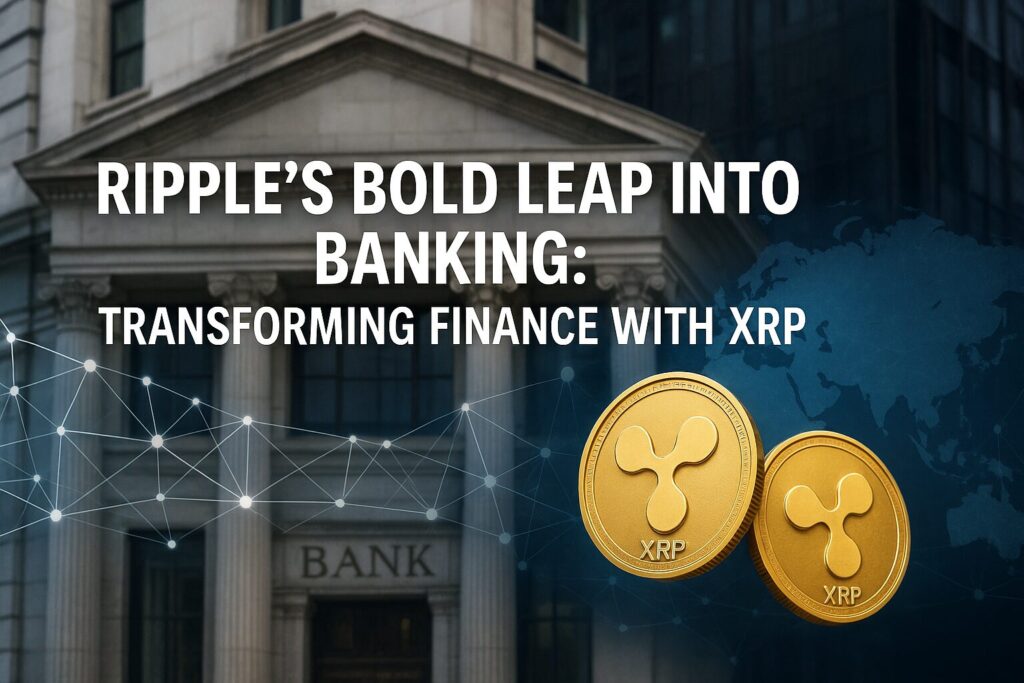
Main Points:
- Ripple has formally applied for a U.S. national bank charter and a Federal Reserve Master Account, marking a pivotal shift from crypto innovator to licensed banking institution.
- XRP surged on the news, reflecting growing institutional confidence; technical analysts point to bullish patterns that may drive prices toward $2.65–$3.00.
- The application promises faster, cheaper cross-border payments, leveraging XRP and RLUSD stablecoin under federal and state oversight.
- If approved, Ripple’s charter could accelerate global adoption of blockchain banking, challenging traditional banks and reshaping international remittances.
- Japan’s financial sector will face intensified pressure to integrate crypto rails or risk losing ground as Ripple’s model proves scalable and low-cost.
1. From Crypto Challenger to Chartered Bank
In early July 2025, Ripple Labs took a decisive step toward mainstream finance by applying for a national bank charter from the U.S. Office of the Comptroller of the Currency (OCC) and a Master Account with the Federal Reserve. CEO Brad Garlinghouse announced on X (formerly Twitter) that this dual application aims to place Ripple’s operations under comprehensive federal and state supervision, following in Circle’s footsteps as it seeks its own trust bank license.
By securing a national charter, Ripple would gain the legal authority to offer deposit-taking, lending, and payment services directly, rather than simply providing technology to banks. This strategic move signals Ripple’s ambition to become a one-stop blockchain bank—issuing its RLUSD stablecoin reserves directly with the Fed and settling payments instantly via XRP, bypassing multiple correspondent banks and reducing processing times from days to seconds.
2. XRP Reacts: Price Surge and Technical Outlook
Within hours of the announcement, XRP experienced a palpable uptick. On July 2, 2025, XRP rose approximately 3.2% to trade around $2.28, its highest level in several weeks. This immediate market response underscores two key drivers: regulatory clarity and institutional legitimization.
2.1 Technical Indicators and Price Targets
Analysts have identified an inverted head-and-shoulders formation on XRP’s daily chart, a classic reversal pattern suggesting a breakout toward $2.65, with a longer-term target near $3.00 if momentum sustains. Support now sits near $2.14, offering a buffer against downside risk in case of broader market pullbacks.
2.2 Institutional Adoption Signals
Beyond technicals, XRP’s inclusion in Grayscale’s newly approved multi-asset ETF has further validated its appeal to regulated investors. The convergence of a banking charter and ETF access could create a feedback loop: greater institutional inflows elevate price and liquidity, which in turn attract more traditional financiers. Yet regulatory uncertainty persists, particularly concerning ongoing SEC litigation over XRP’s securities status, which could pose hurdles to sustained gains.
3. Reinventing Cross-Border Payments
At the heart of Ripple’s charter bid is the promise to revolutionize international remittances. Today, sending $1,000 overseas through conventional banks can cost 5–7% in fees and take 2–3 business days. Ripple’s On-Demand Liquidity (ODL) service uses XRP as a bridge currency, requiring no pre-funded nostro accounts and slashing both cost and settlement time to under a minute.
3.1 RLUSD: A Federally Supervised Stablecoin
Ripple launched its USD-pegged stablecoin, RLUSD, in October 2024, with a market capitalization of approximately $470 million. By holding RLUSD reserves directly at the Fed via a Master Account, Ripple would offer unprecedented transparency and security, addressing one of the biggest trust barriers for stablecoins. Under federal oversight, RLUSD could set a new compliance standard for payment tokens and dethrone incumbents like USDC and USDT in business-to-business corridors.
3.2 Implications for Japanese Financial Institutions
Japanese banks and payment providers already experimenting with blockchain will face fresh competitive pressure. If Ripple’s bank charter is approved, Japanese firms may need to accelerate integration of XRP rails or develop proprietary DLT solutions to compete on cost and speed. Consumer remittance corridors between Japan and Southeast Asian markets, which currently suffer from high fees, stand to benefit enormously if Ripple’s model gains traction. Proactive Japanese institutions could partner with Ripple or deploy similar tokenized liquidity pools to maintain market share.
Conclusion: A New Era of Crypto-Banking Integration
Ripple’s application for a U.S. national bank charter and Fed Master Account marks a watershed moment in the convergence of blockchain and traditional finance. By embedding XRP and RLUSD under robust federal and state regulation, Ripple aims to offer a banking-grade, low-cost, real-time payments infrastructure that rivals legacy systems. The immediate XRP price rally reflects market confidence, while technical patterns hint at further upside.
Should the OCC and Federal Reserve grant approval, Ripple will not only enhance its credibility but also challenge global banks to modernize or risk obsolescence. For investors hunting the next crypto opportunity, XRP’s institutional stairway—and the accompanying regulatory clarity—could catalyze significant growth. Meanwhile, financial institutions in Japan and beyond must adapt swiftly, integrating tokenized settlement rails or forging strategic alliances to stay competitive.
Ripple’s bold leap into banking may reshape how money moves worldwide, heralding a new era where blockchain-powered banks deliver on the promise of faster, cheaper, and more transparent financial services.

